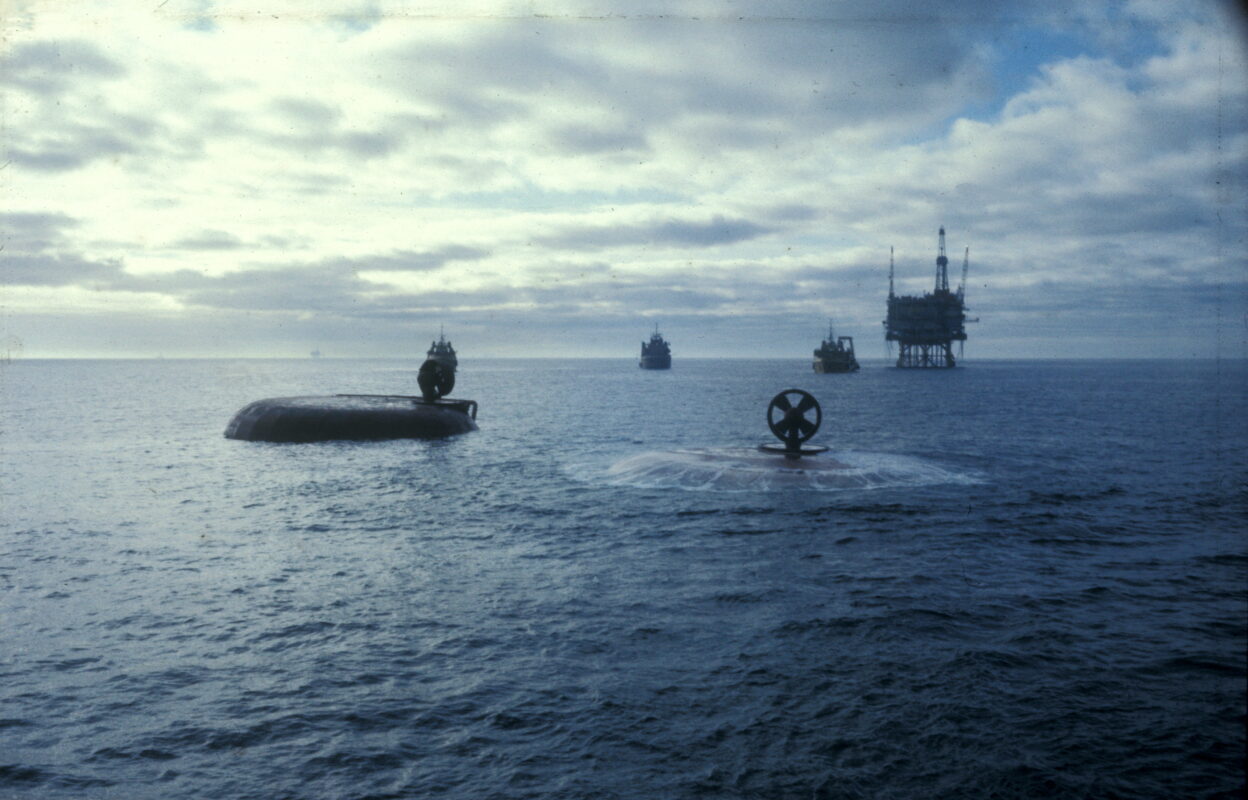Towing the Capsized Kielland rig

After the accident on March 28, 1980, there were still some intact anchors preventing the Kielland wreckage from drifting away. However, the rig still moved in accordance with waves and wind direction. The supply boats Tender Power, Normand Rock, and Normand Rough were assigned the task of maintaining the rig’s position alongside the Edda platform. While the rig was in this position, preparations for towing were made. The rig’s condition was assessed, and search operations for deceased were carried out on the seabed from diving ships.
A critical situation arose on March 31st when one of the boats experienced an engine failure. In other weather conditions, this incident could have had more serious consequences, but fortunately the problem was repaired in time. The crew faced other challenges as well. Captain Bjørn Bakke on the Tender Power noted in the log that the sick bay had to be used to accommodate sleeping space for everyone involved in towing the wreckage ashore. There were also limitations in the onboard water supply, preventing the use of the washing machine. The dishwasher was already out of order, increasing the workload for the cook. Uncertainty regarding when the actual towing could begin and how to secure supplies along the way was challenging, especially with Easter approaching and many places closing. Most boats ran out of fresh provisions such as milk and bread. Some had to do without coffee and cigarettes. Nevertheless, the crew managed the situation with assistance from other nearby boats and platforms.
On April 5th at 09:15, they received a towing permit from the Norwegian Maritime Authority. After several days of preparation and inspections, the crew was finally ready to begin the towing process, but it would take a few more days before they could set off.
Before the towing could commence, all anchor wires had to be cut. On April 7th, divers from the Wildrake cut the final anchor wire, and a trial runwas conducted to test the rig’s stability.
By Tuesday, April 8th, the wind was picking up and there were high waves. The tugboats had to work hard to maintain the wreckage’s position. The crane boom still hung from the rig, posing a threat to the towing convoy. Therefore, the decision was made to cut the crane boom, which required careful planning to ensure it was done safely and efficiently.
Finally, on Friday, April 11th, the actual towing out of the Edda field could begin. The towing convoy consisted of the Tender Power fixed in the C-leg, Nordmand Rock on starboard in the B-leg, and Nordmand Rough on port side in the E-leg. The trawlers Store Knut and Espvær flanked the towing, with a net between them to prevent objects from floating away. Ahead of the convoy, the boat Geo Boy went on route to Kvitsøy to check conditions. Following behind was the diving ship Wildrake ready to retrieve any objects that fell off the rig.
On April 14th at 14:40, the crew observed large objects, possibly living quarters, falling off the rig. Despite extensive searches, nothing was found, and Wildrake returned to the convoy at 22:00. The trawler net placed under the platform only caught fish.
The rest of the towing proceeded in fine weather without major challenges until Saturday night, April 19th. Then, a storm with winds of up to 10 struck. The convoy was nearing the Norwegian coast. At 8:15, they received assistance from a pilot near Kvitsøy. The rig was directed to a temporary anchorage at Årvikholmen off the coast of Kårstø in Tysvær municipality. The towing had been going on for six days and five minutes.
The following Sunday, April 20th, the rig was safely anchored at Kårstø. It remained there for five months before being towed into the Gandsfjord near Stavanger, ahead of the first salvage attempt.
Further reading:
Read the full journal of Captain Bjørn Bakke on the Tender Power regarding the towing in the Digital Archives here:
https://media.digitalarkivet.no/view/105514/72
J. J. Brekke from the Ship Control in Stavanger’s report from the towing
https://media.digitalarkivet.no/view/112046/205
About the ships involved:
Tender Power was a boat from Wilhelmsen Offshore in Tønsberg. https://media.digitalarkivet.no/view/109861/306
The Solstad boats: Several of the boats involved in the salvage and rescue operations after the Alexander Kielland accident had names starting with “Nordmand.” All of these were vessels owned by Solstad Offshore ASA, based in Karmøy. https://media.digitalarkivet.no/view/109861/316
It is also possible to find some of the invoices issued to Phillips Petroleum Company after the towing. https://media.digitalarkivet.no/view/109866/65
arrow_backWhat happened to Henrik Ibsen?Initial investigations of the wreckage after the rig was towed ashorearrow_forward
